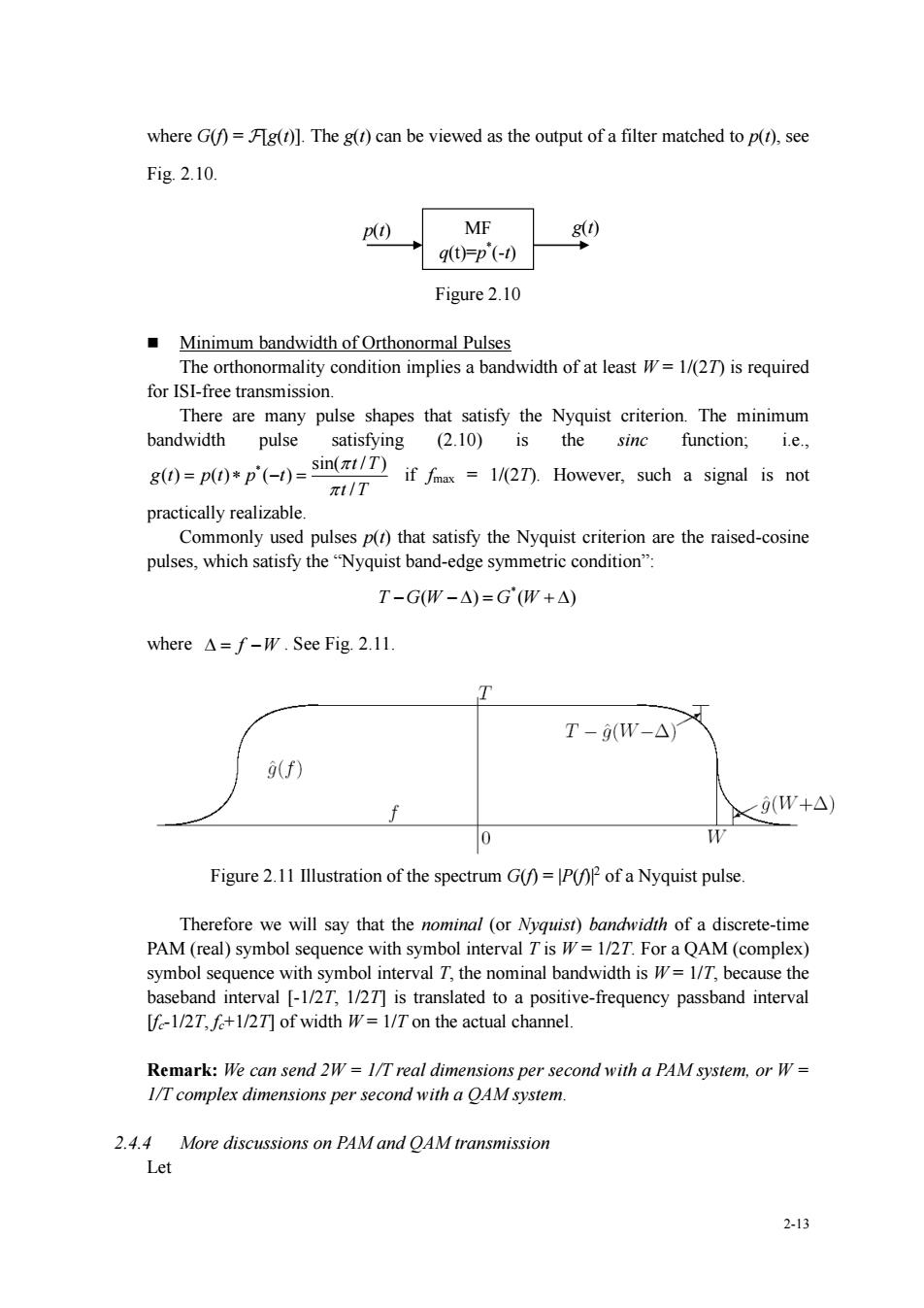正在加载图片...

where G()=Fg()].The g(r)can be viewed as the output of a filter matched to p().see Fig.2.10 p() MF 0 q(t)-p(-1) Figure 2.10 Minimum bandwidth of Orthonormal Pulses The orthonormality condition implies a bandwidth of at least W=1/(27)is required for ISI-free transmission. Ther are many pulse shapes that satisfy the Nyquist criterion.The minimum bandwidth pulse satisfying (2.10)is the sinc function;i.e., 80=p0*p(-)=sinπt/T 1/T if fiax =1/(27).However,such a signal is not practically realizable Com only used pulses p()that satisfy the Nyquist criterion are the raised-cosine pulses,which satisfy theNyquist band-edge symmetric condition" T-GW-△)=G(W+△) where A=f-W.See Fig.2.11. 2 T-g(W-△) (f) <(W+△) 公 Figure 2.11 Illustration of the spectrum G()=P()P of a Nyquist pulse. Therefore we will say that the nominal (or Nyquisr)bandwidih of a discrete-time PAM(real)symbol sequenc e with symbol i For a QAM(complex) symbol sequence with symbol interval T,the nominal bandwidth is=1/T,because the baseband interval [-1/27,1/27]is translated to a positive-frequency passband interval Uf-1/2T,fe+1/2T]of width W=1/T on the actual channel. Remark:We can send 2W=I/T real dimensions per secondwith a PAM system.or W I/T complex dimensions per second with a OAM system. 2.4.4 More discussions on PAM and OAM transmission Let 2-132-13 where G(f) = [g(t)]. The g(t) can be viewed as the output of a filter matched to p(t), see Fig. 2.10. Figure 2.10 ◼ Minimum bandwidth of Orthonormal Pulses The orthonormality condition implies a bandwidth of at least W = 1/(2T) is required for ISI-free transmission. There are many pulse shapes that satisfy the Nyquist criterion. The minimum bandwidth pulse satisfying (2.10) is the sinc function; i.e., * sin( / ) ( ) ( ) ( ) / t T g t p t p t t T = − = if fmax = 1/(2T). However, such a signal is not practically realizable. Commonly used pulses p(t) that satisfy the Nyquist criterion are the raised-cosine pulses, which satisfy the “Nyquist band-edge symmetric condition”: * T G W G W − − = + ( ) ( ) where = −f W . See Fig. 2.11. Figure 2.11 Illustration of the spectrum G(f) = |P(f)|2 of a Nyquist pulse. Therefore we will say that the nominal (or Nyquist) bandwidth of a discrete-time PAM (real) symbol sequence with symbol interval T is W = 1/2T. For a QAM (complex) symbol sequence with symbol interval T, the nominal bandwidth is W = 1/T, because the baseband interval [-1/2T, 1/2T] is translated to a positive-frequency passband interval [fc-1/2T, fc+1/2T] of width W = 1/T on the actual channel. Remark: We can send 2W = 1/T real dimensions per second with a PAM system, or W = 1/T complex dimensions per second with a QAM system. 2.4.4 More discussions on PAM and QAM transmission Let MF q(t)=p * (-t) p(t) g(t)